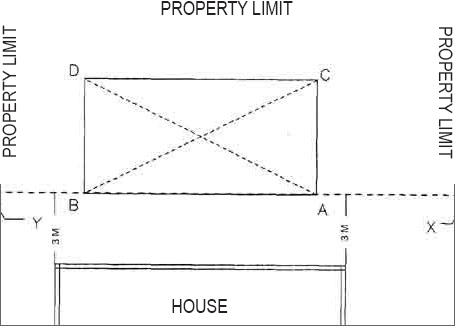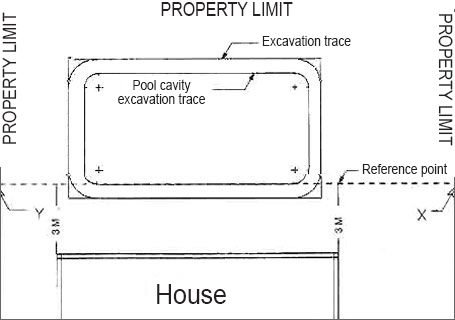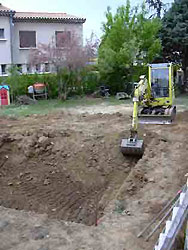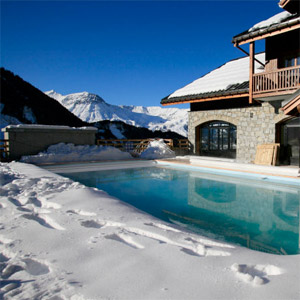 FAQ - Swimming Pool Online advice and recommendations
FAQ - Swimming Pool Online advice and recommendations Installation guide for pool kit
Installation guide for pool kit  Tracing and excavation, our recommendations before your pool build
Tracing and excavation, our recommendations before your pool build Tracing and excavation, our recommendations before your pool build
Installation guide for pool kit
The composition of a pool kit
Tracing and excavation of your pool
Fitting the panels of your pool kit
You need to excavate your pool cavity to allow natural water drainage, opposing the direction of the pool.
Landscape the area with a gradient favouring water evacuation. The pool must be at least 12 to 15 cm above ground level. This creates a gradual slope from the terrace area. Avoid downspouts running towards the pool area as this could risk saturation and water clogging or run into the excavation cavity.
Be sure to orientate your pool towards the best exposition of sunlight possible.



Once the tracing is complete and clearly marked, there are several steps to follow before beginning to dig the cavity:
1. Make sure there is clear access to the site and protect the extremities of your land with builders boards to minimise damage to the footpath or road.
Clear any shrubs or trees that may be in the way and ensure that you have all necessary permission from the local authorities (planning permission or other).
2. You have defined the level (or elevation) of your pool. If you do not have a pre-established reference point, use a builder's level to measure at least four elevation points which represent the four corners of the pool rectangle.
You will use the highest of these four points as a reference. Mark the point of reference and transfer to a fixed point in the garden (a fence post or house wall) to be used for reference during construction.

3. Once elevation is determined, you can mark the point of the bottom of the pool wall on the deep end of the pool. To find this point, measure 1.12m above the reference point. This is the level of the shallow end and the ledge on which the pool panels will be placed. To find the maximum depth of the pool, measure 1.60m above the reference point, that will measure as 2.75m on the ranging pole. Position marking tape on reference points for pool ledge and maximum depth on the ranging pole.
4. Now those depth markings are established, remove grass situated on the trace excavation line using a spade. At points of frequent passage, place a picket on ground level at intervals of 4.30m to 5.50m. This will assist you to find the edge of evacuation points even if they are accidentally erased by digging machines.


Use a pickaxe and shovel to level lateral irregularities. It is important to lift all loose earth and flatten the pool cavity carefully.
Once this has been completed, check all dimensions and mark the flat surface and edges on which the walls will be placed. It is essential to follow exactly the indicated dimensions on your excavation plan. If a main drain is included in the conception of your pool, find the centre point at the deepest part of your pool floor and dig a hole 45 x 60 cm for sump.
In the case of sand textured earth, make the sump reservoir a little bigger allowing a better fitting of panels. Evacuate any surplus after fixing the base with mortar.
Digging on rock requires specific material (rock breakers).
Surplus water will require a drain that consists of a layer of gravel in the pool cavity. You need to account the excavation deeper to take into the layer of gravel. Gravel ensure the water evacuates without damaging the excavation cavity edges.
The installation of a suction valve connected to the pump allows water to be drained from the excavation during the construction process.
The quantity of earth to be kept for landscaping is determined by the topography of the garden and the degree of adjustment in coherence with the modified slope.
Next step : Fitting the panels of your pool kit
The composition of a pool kit
Tracing and excavation of your pool
Fitting the panels of your pool kit
Tracing your pool perimeter
You need to excavate your pool cavity to allow natural water drainage, opposing the direction of the pool.
Landscape the area with a gradient favouring water evacuation. The pool must be at least 12 to 15 cm above ground level. This creates a gradual slope from the terrace area. Avoid downspouts running towards the pool area as this could risk saturation and water clogging or run into the excavation cavity.
Be sure to orientate your pool towards the best exposition of sunlight possible.
If, for example, the pool is 3 meters from the back of the house :
Position two marking pickets in the ground, the first picket 3 meters from one end of the house, the second picket 3 meters from the opposite end of the house.
Pull a cord between the two pickets and lead them to your property limit. We will call these two points x and y. The line between point x and y is your reference point. As the reference point is off limits for any other use or access, this reference point can be used to line up your steel panels during construction.
To determine the position of the first corner of your pool, define a point on the xy line and mark with a picket. We will call this point A.
From point A, measure the length of your pool and mark with a picket. We will call this point B.
To measure the two opposing corners : measure from point A, a 90° angle equal to the width of your pool, and mark with a picket. We will call this point C.
Repeat the same process from point B. Mark with a picket. We will call this point D.
Measure the distance between point C and D ensuring that the distance is equal to that between points A and B.
To check that your four corner angles are straight, check that the distances between AD and BC are equal.
If the pool features rounded angles, repeat the following procedure for each angle:
For a rounded corner with a 0,60 m radius: measure 0,60 m from one corner picket with a marking line lengthways. Repeat the operation with another marking picket and line widthways. Determine the intersection point of these two lines at 0.60 m from the inside of the large rectangle. Mark the precise crossing point with a marking picket, and attach a line. Trace a 1/4 circle form (ensuring the radius of 0.60m between picket 1 and 2) and trace with a marking spray. Repeat this process for each corner.
Your pool is now traced…
To convert the tracing of the pool into your excavation trace, draw a perimeter line 0.60m from the outside the pool trace perimeter. This takes into account the space needed for the panel braces. Use marking spray to effectuate tracing.
Free form pool :
Whatever its shape, a pool always has a rectangular base, representing length and width as the largest dimensions of the pool. If the rectangle is drawn, you can easily determine the central points that will be used to create the arcs that will form the desired shape of pool.
Position two marking pickets in the ground, the first picket 3 meters from one end of the house, the second picket 3 meters from the opposite end of the house.
Pull a cord between the two pickets and lead them to your property limit. We will call these two points x and y. The line between point x and y is your reference point. As the reference point is off limits for any other use or access, this reference point can be used to line up your steel panels during construction.
To determine the position of the first corner of your pool, define a point on the xy line and mark with a picket. We will call this point A.
From point A, measure the length of your pool and mark with a picket. We will call this point B.
To measure the two opposing corners : measure from point A, a 90° angle equal to the width of your pool, and mark with a picket. We will call this point C.
Repeat the same process from point B. Mark with a picket. We will call this point D.
Measure the distance between point C and D ensuring that the distance is equal to that between points A and B.
To check that your four corner angles are straight, check that the distances between AD and BC are equal.
If the pool features rounded angles, repeat the following procedure for each angle:
For a rounded corner with a 0,60 m radius: measure 0,60 m from one corner picket with a marking line lengthways. Repeat the operation with another marking picket and line widthways. Determine the intersection point of these two lines at 0.60 m from the inside of the large rectangle. Mark the precise crossing point with a marking picket, and attach a line. Trace a 1/4 circle form (ensuring the radius of 0.60m between picket 1 and 2) and trace with a marking spray. Repeat this process for each corner.
Your pool is now traced…
To convert the tracing of the pool into your excavation trace, draw a perimeter line 0.60m from the outside the pool trace perimeter. This takes into account the space needed for the panel braces. Use marking spray to effectuate tracing.
Free form pool :
Whatever its shape, a pool always has a rectangular base, representing length and width as the largest dimensions of the pool. If the rectangle is drawn, you can easily determine the central points that will be used to create the arcs that will form the desired shape of pool.



Excavation
Once the tracing is complete and clearly marked, there are several steps to follow before beginning to dig the cavity:
1. Make sure there is clear access to the site and protect the extremities of your land with builders boards to minimise damage to the footpath or road.
Clear any shrubs or trees that may be in the way and ensure that you have all necessary permission from the local authorities (planning permission or other).
2. You have defined the level (or elevation) of your pool. If you do not have a pre-established reference point, use a builder's level to measure at least four elevation points which represent the four corners of the pool rectangle.
You will use the highest of these four points as a reference. Mark the point of reference and transfer to a fixed point in the garden (a fence post or house wall) to be used for reference during construction.

3. Once elevation is determined, you can mark the point of the bottom of the pool wall on the deep end of the pool. To find this point, measure 1.12m above the reference point. This is the level of the shallow end and the ledge on which the pool panels will be placed. To find the maximum depth of the pool, measure 1.60m above the reference point, that will measure as 2.75m on the ranging pole. Position marking tape on reference points for pool ledge and maximum depth on the ranging pole.
4. Now those depth markings are established, remove grass situated on the trace excavation line using a spade. At points of frequent passage, place a picket on ground level at intervals of 4.30m to 5.50m. This will assist you to find the edge of evacuation points even if they are accidentally erased by digging machines.
Rent a mechanical digger or hire a contractor to excavate the pool cavity.
Begin at the shallow end. Dig to the predetermined depth.
Mark the limit between the shallow end of the pool and the beginning of the deep end using marking spray.
This lets the digger driver clearly see a straight line when making the transition to the deep end of the pool.
Continue to dig the length of the pool edges at the same depth as the shallow side.
Begin at the shallow end. Dig to the predetermined depth.
Mark the limit between the shallow end of the pool and the beginning of the deep end using marking spray.
This lets the digger driver clearly see a straight line when making the transition to the deep end of the pool.
Continue to dig the length of the pool edges at the same depth as the shallow side.

Once one side has been levelled in total, mark the point at the pool edge where the gradual slope begins.
Measure a distance of 60 cm inside the excavation trace (see schema).
Using a plumb line, transfer this measurement to a levelled point. Mark with builders paint.
The digger driver can now excavate the supplement of earth.
To maintain the correct gradual slope of the lateral wall, measure a distance of 1,20 m from the side of the slope towards the inside of the excavation cavity.
Using a plumb line, transfer this point the floor of the excavation cavity.
Measure a distance of 60 cm inside the excavation trace (see schema).
Using a plumb line, transfer this measurement to a levelled point. Mark with builders paint.
The digger driver can now excavate the supplement of earth.
To maintain the correct gradual slope of the lateral wall, measure a distance of 1,20 m from the side of the slope towards the inside of the excavation cavity.
Using a plumb line, transfer this point the floor of the excavation cavity.

Use a pickaxe and shovel to level lateral irregularities. It is important to lift all loose earth and flatten the pool cavity carefully.
Once this has been completed, check all dimensions and mark the flat surface and edges on which the walls will be placed. It is essential to follow exactly the indicated dimensions on your excavation plan. If a main drain is included in the conception of your pool, find the centre point at the deepest part of your pool floor and dig a hole 45 x 60 cm for sump.
In the case of sand textured earth, make the sump reservoir a little bigger allowing a better fitting of panels. Evacuate any surplus after fixing the base with mortar.
Digging on rock requires specific material (rock breakers).
Surplus water will require a drain that consists of a layer of gravel in the pool cavity. You need to account the excavation deeper to take into the layer of gravel. Gravel ensure the water evacuates without damaging the excavation cavity edges.
The installation of a suction valve connected to the pump allows water to be drained from the excavation during the construction process.
The quantity of earth to be kept for landscaping is determined by the topography of the garden and the degree of adjustment in coherence with the modified slope.
Next step : Fitting the panels of your pool kit
Photos non-contractual











